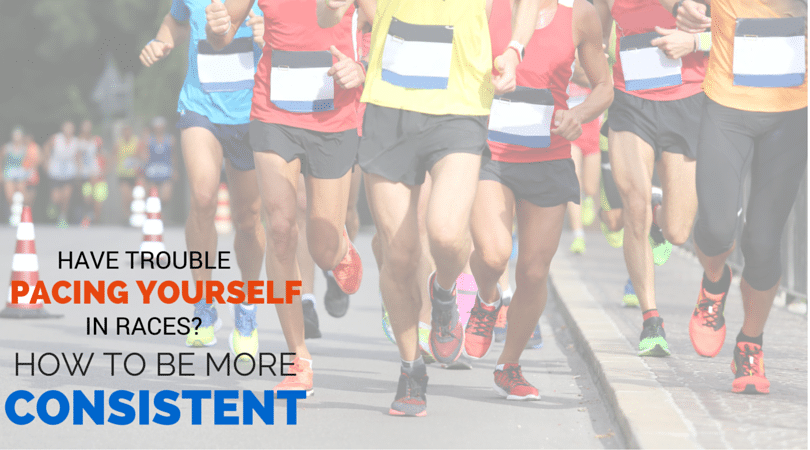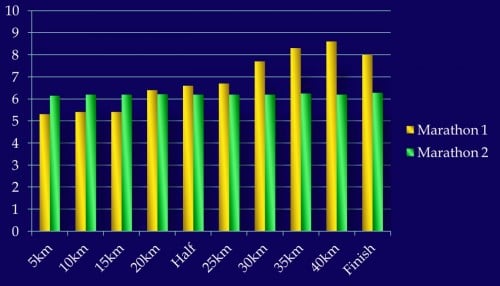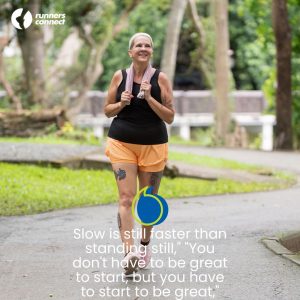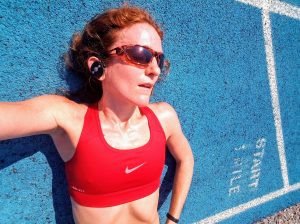There is nothing more satisfying than crossing the line of a race knowing you’ve got it right… You paced it perfectly, didn’t blow up, ran strong, and got the best out of yourself.
It’s a fantastic, empowering feeling. So good in fact, that the final finish time almost doesn’t matter, because you know you hit your pacing perfectly and it feels great. You did your absolute best on the day and you can’t ask for more than that.
Like many runners however, I can count the times I’ve felt like that on one hand. Sometimes it’s coincided with a great time, even a personal best; other times it hasn’t. But that doesn’t actually matter that much.
When you know you’ve done everything you can and it’s all come together perfectly….well that’s priceless, and the finish time? Well the finish time will be what the finish time will be.
If that also happens to be a personal best, then you’ve hit gold.
But if that feeling is so elusive, and perfect pacing is so hard to get right, is there anything you can do to learn how to pace more effectively?
There are so many variables in running the perfect race. Some you can control; others you can’t. Even when you’re well prepared variables such as weather conditions, other runners, technology failure, how you feel on the day, and your own health and hydration status will all play a part in how things can rapidly change on the day.
Being able to pace well includes the ability to be flexible and adapt to changing circumstances mid race.
How Can I Learn to Pace Myself in a Race?
Ultimately your ability to pace well needs to become intuitive.
Something you can only learn through training, racing and experience. Get to know your body (and mind) inside out and trust your innate ability to hit the right pace, without always needing a watch to tell you.
Pacing well involves being able to distribute your energy over the length of the course for your optimum performance, whether that’s a 5km or ultra-marathon.
But that’s easier said than done.
Before you head into a race, you do need some sort of approximate time to aim for; but not a ‘set in stone’ target. Keep it more ‘vague’ and you can then work with your body and what the race throws at you on the day.
Look to the Evidence.
The first step is to reflect on your training.
Where is your fitness right now? What sort of times are you running in training? In other races?
Be honest with yourself. If you struggle to run 9 min/miles for short distances, then you won’t suddenly be able to knock out the same pace in a marathon, no matter how much you want to.
Keep a training diary so you can compare previous races, runs and performances. A detailed record of training and races will allow you to analyze your current form.
Train with Heart Rate
Last week, we showed you how to determine if heart rate training will work for you.
If you decided that you are the kind of runner it will help, training with it will give you a clearer picture of how your pace, heart rate, and perceived exertion all correlate, and how that might look at varying distances.
Training with heart rate can help teach you more about your body, how it responds and what heart rates equate to different paces. That helps with ‘pace feel’ and what you can sustain for different race distances.
Should I Race with Heart Rate?
Not so fast.
British Olympic Marathoner Liz Yelling (with a best of 2:28.33) says ‘’I never use heart rate during a race. It’s off putting and distracting. If anything it can cause you to run slower than you’re really capable of’. ”
Although new runners and complete beginners who aren’t used to racing, might find it useful to run with a heart rate monitor in a race, especially in a marathon or ultra.
It will just help you keep your pace under control in the first few miles and prevent you going off too fast.
As a guide, stick to 70-75% of your maximum heart rate in a marathon, at least for the first half. That will just keep your pace on track and your enthusiasm under control.
How Can I See my Fitness Gains?
Having a way to measure true fitness gains, rather than performance, allows you to get in tune with your body and teaches you about pace and effort level.
Every other week – run a 5 mile loop and record your average heartrate and time for the distance.
This is not a ‘time trial’.. simply a timed easy run at around 70% of your max. Observe the correlation between your average heart rate and the time take to run the 5 miles and look for improvements.
If you’re in great shape coming into a race, you’ll notice a lower average heart rate for the same time or even faster.
How Do I Predict my Time to Understand What Pace to Use?
Your training and racing evidence will provide the guidance you need to work out an approximate time to shoot for in your race.
Keep in mind that you will need to train the specific energy systems for the various race distances. It does not mean if you have trained yourself to run a 26 minute 5k that you can run a 4 hour marathon the next weekend.
RunnersConnect Bonus
Download your FREE Improvement Performance Calculator now.
This handy pace calculator helps you to determine what pace you should be running at in training and at each racing distance based on a recent race result.
For masters readers, we have an age grading calculator that provides a range of times that includes your age based percentages.
Remember that many of these predictors predict fast (and possibly unrealistic) marathon times off the back of a 10km or half marathon time. Err on the side of caution and use your training and long runs as evidence of your current ability instead.
Predicting Marathon Time Based off a Recent Half Marathon
New runners or first time marathoners can calculate their marathon time (and therefore pace) by taking their half marathon time multiplying it by 2, and adding 20-30 minutes.
More experienced runners or faster runners can calculate their marathon time (and therefore pace) by taking their half marathon time multiplying it by 2, and adding 10-15 minutes.
How Do You Run By ‘Feel’?
The more you train and monitor your results and stats, the more you can get in tune with your body. Every run and race teaches you something, so track the data and evidence and use it to learn from.
Train at different paces, learn how your body responds and build up a wide ‘range’ of paces – possibly 2 mins/mile between your ‘easy’ pace and your ‘10km’ or race pace. You can also use the pace calculator we referred to above to determine your training paces.
Now:
RPE is your Rating of Perceived Exertion. Imagine on a scale of 1-10 (with 10 being the hardest). Your RPE is how your pace feels to you. RPE is very individual and different for everyone.
Studies show that as you get fitter, your RPE gets lower for the same ‘ physical exertion’. Basically it just feels easier even though your body is working at the same effort level.
Unfit and new runners may find that an easy pace feels very hard (their RPE is higher), when in fact their actual effort level and heart rate is quite low. As they get fitter that will improve.
As you get more experienced, you’ll get a better understanding of your own RPE at different paces and heart rates.
As a general guide race:
Marathon = RPE 5/10
Half Marathon = RPE 6/10… push to 7 or 8/10 in the final miles
10km = 8/10
5km = 9/10
But this is all very subjective and individual. Some runners will be able to sustain higher or lower RPE’s than others. The point is to have different RPE’s for different race distances. Experiment in training and get a feel for it.
How to Get it Right on Race Day
To pace well it takes experience, race and training practice and an awareness of how you’re feeling on the day.
Don’t set yourself up for failure by setting an unrealistic goal time or announcing to the world that you want to run ‘sub 4’ for the marathon. See how you feel on the day, then make a call.
Have an approximate time in mind before you start, then use a combination of pace, RPE, and ‘feel’ to guide you. But don’t set out with a rigid goal time in mind. Be flexible and work with how you feel on the day
Avoid obsessing over your watch or pace… try to relax and run to ‘feel’ and RPE instead.
Don’t stick religiously to a pace. On the day you might find it’s actually too slow and you could be holding back. Or vice versa.
Listen to your body and trust it. It will guide you if you let it.
Liz Yelling agrees “Pacing was important to me. I tried to run even paced as possible in marathon races. I always knew my mile splits and other set target splits throughout the race. Although when you’re racing it’s hard to keep a lid on it! Sometimes you just have to go with how you feel on the day!”
Still Not Convinced? Maybe this Will Help
I’ll leave you with a true story about my friend and coaching client Pete. He’s a great runner, really enthusiastic and has learned a lot about himself over the 2-3 years he’s been running.
Like many, he ran his first marathon and blew up. Paced it badly, went off too fast, and felt really disappointed with his time. He was trying to use his min/km splits to keep him on track, but like many runners shot off too fast, hit the wall and the last 8 miles were painful and slow.
By the time marathon 2 came along a year later he was more experienced.
He had done a lot more training and racing and knew more about his pace and how to keep the reigns on. He was all set to run around 6:15-20 min/km and was looking for a finish time of around 4:30. But after only 2 miles his watch battery died and he didn’t have a clue about the pace he was running.
After initially feeling stressed and a bit panicky, he realized he had no choice but continue and try to run by ‘feel’ and go with the flow for the rest of the race.
Coming towards the finish he was surprised to find he was actually on track.. he could see the clock and it said 4:29. He finished in just over 4:30.
When he downloaded his splits later on he realised he had run 6:14-6:27 min/km for the entire race. Nothing more than a 13 second difference between his fastest and slowest km split the whole way round. Without a watch.
This graph shows his splits:
Morale of the story?
Run to feel. Learn what that feels like for you. Get to know your breathing rate and work with perceived exertion.
Relax, be flexible and go with the flow. And maybe don’t wear a watch?






